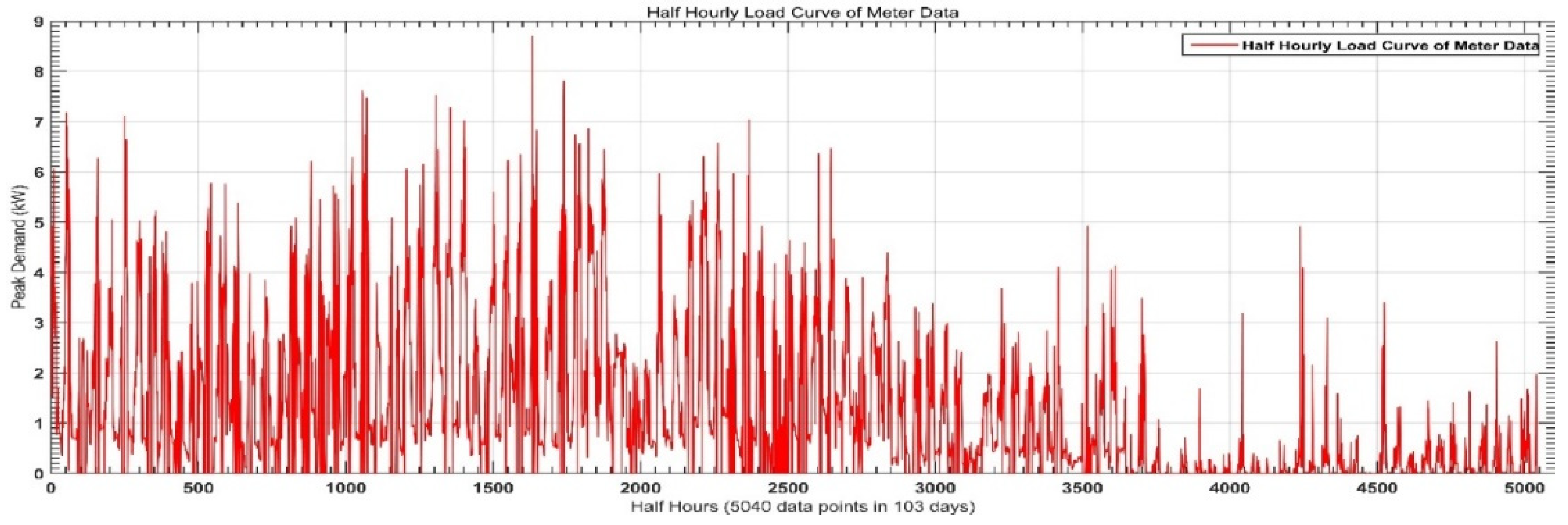Comparison of Regression and Neural Network Model for Short Term Load Forecasting: A Case Study †
Abstract
:1. Introduction
2. Methodology
3. Results
4. Conclusions
Conflicts of Interest
References
- Mufti, G.M.; Jamil, M.; Nawaz, M.; Hassan, S.Z.; Kamal, T. Evaluating the Issues and Challenges in Context of the Energy Crisis of Pakistan. Indian J. Sci. Technol. 2016, 9, 36. [Google Scholar] [CrossRef]
- Chae, Y.T.; Horesh, R.; Hwang, Y.; Lee, Y.M. Artificial neural network model for forecasting sub-hourly electricity usage in commercial buildings. Energy Build. 2016, 111, 184–194. [Google Scholar] [CrossRef]
- Yildiz, B.; Bilbao, J.; Sproul, A. A review and analysis of regression and machine learning models on commercial building electricity load forecasting. Renew. Sustain. Energy Rev. 2017, 73, 1104–1122. [Google Scholar] [CrossRef]
- Ahmad, A.; Hassan, M.; Abdullah, M.; Rahman, H.A.; Hussin, F.; Abdullah, H.; Saidur, R. A review on applications of ANN and SVM for building electrical energy consumption forecasting. Renew. Sustain. Energy Rev. 2014, 33, 102–109. [Google Scholar] [CrossRef]
- Ying, L.-C.; Pan, M.-C. Using adaptive network based fuzzy inference system to forecast regional electricity loads. Energy Convers. Manag. 2008, 49, 205–211. [Google Scholar] [CrossRef]
- Khwaja, A.; Naeem, M.; Anpalagan, A.; Venetsanopoulos, A.; Venkatesh, B. Improved short-term load forecasting using bagged neural networks. Electr. Power Syst. Res. 2015, 125, 109–115. [Google Scholar] [CrossRef]
- Panapakidis, I.P. Clustering based day-ahead and hour-ahead bus load forecasting models. Int. J. Electr. Power Energy Syst. 2016, 80, 171–178. [Google Scholar] [CrossRef]
- Koprinska, I.; Rana, M.; Troncoso, A.; Martínez-Álvarez, F. Combining pattern sequence similarity with neural networks for forecasting electricity demand time series. In Proceedings of the 2013 International Joint Conference on Neural Networks (IJCNN), Dallas, TX, USA, 4–9 August 2013; pp. 1–8. [Google Scholar] [CrossRef]
- Hu, R.; Wen, S.; Zeng, Z.; Huang, T. A short-term power load forecasting model based on the generalized regression neural network with decreasing step fruit fly optimization algorithm. Neurocomputing 2017, 221, 24–31. [Google Scholar] [CrossRef]
- Wang, J.-L.; Wu, H.-N.; Guo, L. Passivity and Stability Analysis of Reaction-Diffusion Neural Networks with Dirichlet Boundary Conditions. IEEE Trans. Neural Networks 2011, 22, 2105–2116. [Google Scholar] [CrossRef] [PubMed]
- Liu, H.; Wang, Z.; Shen, B.; Alsaadi, F.E. state estimation for discrete-time memristive recurrent neural networks with stochastic time-delays. Int. J. Gen. Syst. 2016, 45, 633–647. [Google Scholar] [CrossRef] [Green Version]
- Wang, J.-L.; Wu, H.-N.; Guo, L. Stability analysis of reaction–diffusion Cohen–Grossberg neural networks under impulsive control. Neurocomputing 2013, 106, 21–30. [Google Scholar] [CrossRef]
- Wen, S.; Zeng, Z.; Chen, M.Z.Q.; Huang, T. Synchronization of Switched Neural Networks With Communication Delays via the Event-Triggered Control. IEEE Trans. Neural Networks Learn. Syst. 2017, 28, 2334–2343. [Google Scholar] [CrossRef] [PubMed]
- Li, K.; Su, H.; Chu, J. Forecasting building energy consumption using neural networks and hybrid neuro-fuzzy system: A comparative study. Energy Build. 2011, 43, 2893–2899. [Google Scholar] [CrossRef]
- Panapakidis, I.P. Application of hybrid computational intelligence models in short-term bus load forecasting. Expert Syst. Appl. 2016, 54, 105–120. [Google Scholar] [CrossRef]





| Arrangement of Data | ||
|---|---|---|
| Day/time | Peak Load(kW) of Hours of Days | Forecast |
| 48 Days 48 × 1 matrix | Data from Meter 48 × 24 matrix | 48 H 48 × 1 matrix |
Publisher’s Note: MDPI stays neutral with regard to jurisdictional claims in published maps and institutional affiliations. |
© 2021 by the authors. Licensee MDPI, Basel, Switzerland. This article is an open access article distributed under the terms and conditions of the Creative Commons Attribution (CC BY) license (https://creativecommons.org/licenses/by/4.0/).
Share and Cite
Aslam, J.; Latif, W.; Wasif, M.; Hussain, I.; Javaid, S. Comparison of Regression and Neural Network Model for Short Term Load Forecasting: A Case Study. Eng. Proc. 2021, 12, 29. https://doi.org/10.3390/engproc2021012029
Aslam J, Latif W, Wasif M, Hussain I, Javaid S. Comparison of Regression and Neural Network Model for Short Term Load Forecasting: A Case Study. Engineering Proceedings. 2021; 12(1):29. https://doi.org/10.3390/engproc2021012029
Chicago/Turabian StyleAslam, Javaid, Waqas Latif, Muhammad Wasif, Iftikhar Hussain, and Saba Javaid. 2021. "Comparison of Regression and Neural Network Model for Short Term Load Forecasting: A Case Study" Engineering Proceedings 12, no. 1: 29. https://doi.org/10.3390/engproc2021012029
APA StyleAslam, J., Latif, W., Wasif, M., Hussain, I., & Javaid, S. (2021). Comparison of Regression and Neural Network Model for Short Term Load Forecasting: A Case Study. Engineering Proceedings, 12(1), 29. https://doi.org/10.3390/engproc2021012029






